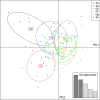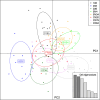Genetic characterization of schistosome species from cattle in Côte d'Ivoire
- PMID: 38475876
- PMCID: PMC10935785
- DOI: 10.1186/s13071-024-06221-9
Genetic characterization of schistosome species from cattle in Côte d'Ivoire
Abstract
Background: Schistosomiasis is a water-based parasitic disease that affects humans, livestock and wild animals. While considerable resources are dedicated to the surveillance, disease mapping, control and elimination of human schistosomiasis, this is not the case for livestock schistosomiasis. Indeed, there are important data and knowledge gaps concerning the species present, population genetic diversity, infection prevalence, morbidity and economic impact. This study aimed to identify circulating schistosome species in cattle across Côte d'Ivoire and to investigate their population diversity and structuring.
Methods: Overall, 400 adult schistosomes were collected from slaughtered cattle at six sites across Côte d'Ivoire. Additionally, 114 miracidia were collected from live cattle at one site: Ferkessédougou, in the northern part of Côte d'Ivoire. DNA from all specimens was extracted and the cox1 and ITS1/2 regions amplified and analysed to confirm species. The genetic diversity and structuring of the schistosome populations were investigated using 12 microsatellite markers.
Results: All adult schistosomes and miracidia presented Schistosoma bovis mitochondrial cox1 profile. Nuclear ITS1/2 data were obtained from 101 adult schistosomes and four miracidia, all of which presented an S. bovis profile. Genetic diversity indices revealed a deficiency of heterozygotes and signals of inbreeding across all sites, while structure analyses displayed little geographic structuring and differentiation. Cattle in Côte d'Ivoire thus appear to be mono-species infected with S. bovis. Hybrids of Schistosoma haematobium × S. bovis have not been identified in this study. Cattle schistosomes appear to be panmictic across the country.
Conclusions: Our results contribute to a deeper understanding of schistosome populations in Ivorian cattle and emphasize a One Health approach of joint human and animal surveillance and prevention and control programmes for schistosomiasis.
Keywords: Schistosoma bovis; Schistosoma curassoni; Cattle; Côte d’Ivoire; Genetic diversity; Genetic structuring; Microsatellites; One Health; Schistosomiasis.
© 2024. The Author(s).
Conflict of interest statement
The authors declare that they have no competing interests.
Figures








Similar articles
-
Population genetic structure of Schistosoma haematobium and Schistosoma haematobium × Schistosoma bovis hybrids among school-aged children in Côte d'Ivoire.Parasite. 2022;29:23. doi: 10.1051/parasite/2022023. Epub 2022 May 3. Parasite. 2022. PMID: 35522066 Free PMC article.
-
Molecular characterization and distribution of Schistosoma cercariae collected from naturally infected bulinid snails in northern and central Côte d'Ivoire.Parasit Vectors. 2019 Mar 19;12(1):117. doi: 10.1186/s13071-019-3381-3. Parasit Vectors. 2019. PMID: 30890180 Free PMC article.
-
High prevalence of Schistosoma haematobium × Schistosoma bovis hybrids in schoolchildren in Côte d'Ivoire.Parasitology. 2020 Mar;147(3):287-294. doi: 10.1017/S0031182019001549. Epub 2019 Nov 21. Parasitology. 2020. PMID: 31727202 Free PMC article.
-
Mapping of schistosome hybrids of the haematobium group in West and Central Africa.J Helminthol. 2024 Sep 18;98:e53. doi: 10.1017/S0022149X24000257. J Helminthol. 2024. PMID: 39291545 Review.
-
Prevalence of bovine trypanosomiasis in Côte d'Ivoire: Systematic review and meta-analysis.Onderstepoort J Vet Res. 2023 Feb 27;90(1):e1-e8. doi: 10.4102/ojvr.v90i1.2069. Onderstepoort J Vet Res. 2023. PMID: 36861927 Free PMC article.
Cited by
-
Identifying key aspects to enhance predictive modeling for early identification of schistosomiasis hotspots to guide mass drug administration.PLoS Negl Trop Dis. 2025 Jul 16;19(7):e0013315. doi: 10.1371/journal.pntd.0013315. eCollection 2025 Jul. PLoS Negl Trop Dis. 2025. PMID: 40668876 Free PMC article.
-
Population genetic structure of Schistosoma bovis and S. curassoni collected from cattle in Mali.Parasite. 2024;31:36. doi: 10.1051/parasite/2024035. Epub 2024 Jul 2. Parasite. 2024. PMID: 38953782 Free PMC article.
References
-
- Kokaliaris C, Garba A, Matuska M, Bronzan RN, Colley DG, Dorkenoo AM, et al. Effect of preventive chemotherapy with praziquantel on schistosomiasis among school-aged children in sub-Saharan Africa: a spatiotemporal modelling study. Lancet Infect Dis. 2022;22:136–149. doi: 10.1016/S1473-3099(21)00090-6. - DOI - PMC - PubMed
-
- WHO. Schistosomiasis Fact Sheet. In WHO. 2022. https://www.who.int/news-room/fact-sheets/detail/schistosomiasis. Accessed May 4 2022.
-
- WHO . Helminth control in school-age children: a guide for managers of control programmes. 2. Geneva: World Health Organization; 2011.
MeSH terms
Grants and funding
LinkOut - more resources
Full Text Sources

